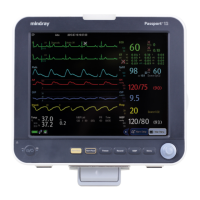Passport 12/Passport 8 Operator’s Manual 8-15
For these cases you should select a lead with good T-wave amplitude and no visible flutter activity, and without a
predominant U-wave or P-wave.
Some conditions such as left or right bundle branch block or hypertrophy can lead to a widened QRS complex. If a long
QTc is observed you should verify it to ensure that it is not caused by QRS widening.
Because normal beats followed by ventricular beats are not included in the analysis, no QT measurement will be
generated in the presence of a bigeminy rhythm.
If the heart rate is extremely high (over 150bpm for adults and over 180bpm for pediatrics and neonates), QT will not be
measured. When the heart rate changes, it can take several minutes for the QT interval to stabilize. For reliable QTc
calculation it is important to avoid the region where the heart rate is changing.
WARNING
QT/QTc measurements should always be verified by a qualified clinician.
8.7.2 Enabling QT/QTc Monitoring
The QT monitoring function is disabled by default. Before you start QT monitoring, enable the QT function.
To enable QT/QTc monitoring:
1. In the [ECG Setup] menu, select [QT Analysis>>] to enter the [QT Analysis] menu.
2. Set [QT Analysis] to [On].
8.7.3 Displaying QT/QTc Parameters and Waveform
To display QT numerics and waveform:
1. Select the [Screens] QuickKey or select [Main Menu]→[Screen Setup >>]→[Screen Layout >> to enter the
[Screens] window.
2. Select the [Screen Setup] tab.
3. Select the parameter area where you want to display the QT parameters and select [QT].
The following picture shows the QT numeric area. Your monitor screen may look slightly different:
2
4
5
3
1

